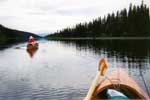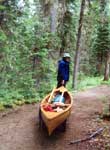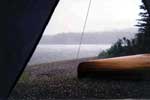Wee
Lassies on Bowron Lakes
by Rick
Crook
Bowron Lakes chain is a provincial park
in central British Columbia and described as one of the ten
best paddles in the world. Click here
for a map and description. I know that when my wife and I have
gone there, many of the other paddlers are German or Swiss who
have gone to great trouble and expense to have a wilderness
experience. The full chain of lakes is about 120 km of paddling,
mostly on lakes, with a couple of rivers to add a bit of interest.
Between the lakes are about 8 fairly short portages, all with
trails suitable for canoe carts, the longest being about 3 km.
Any competent paddlers can handle the trip but once you start
on the chain, there are no roads, no links to civilization so
you must carry all your food and gear for the trip. Motorboats
are only allowed on the last lake of the chain, and most travellers
are in canoes.
 click
pictures to enlarge
click
pictures to enlarge |
Last summer I had just completed a pair
of Wee Lassies, to Mac Macarthy's design and my wife Pat and
I paddled the west half of the chain the first week of July.
One of the rules in the park (to preserve the trails) is that
you can have no more than 60 lbs of gear in your boat when it
is on the wheels. When you have two people, and one boat, that
usually means carrying some of your food on your back over the
portages. We have done the full loop in a full size canoe, but
you have to have supplies for 7 or 8 days and I was not sure
if the solo boats would have the load capacity required. So
we did the west side, paddling down for 3 days to Una Lake,
then back up. Now I would have no problem tackling the complete
loop, as we were able to get by with about 45 pounds in each
boat, and still had lots of freeboard. The lakes are large,
and sudden wind squalls are fairly common, so freeboard can
become an issue. In fact on our last day, coming out of the
marsh onto Bowron Lake there were strong winds and whitecaps
on the lake, and had to work hard to get to shore on the west
side of the lake, to wait out the wind. This was just poor planning
on my part, as the wind quite often is strong for a couple of
hours at the end of the day if the weather has been warm. The
boats handled it like little ducks, took on no water but the
ride was a bit more exciting than I like.
 I
made carts for both boats, so portaging was like a walk in the
park, boats are 30 lb and 45 lb of gear, makes it easy. The
lakes on the west side of the chain are shallow and sandy, with
lots of moose and other wildlife. Una lake is crystal clear,
you can see schools of Dolly Varden swimming around the bottom
15 feet down. If you go, there is a bit of planning involved,
there are no canned or bottled beverages allowed in the park(makes
for no litter) and you should not drink the water unless you
boil it or filter it. Freeze dried food helps with the weight,
remember you may have to carry it, and a good waterproof tent
and warm sleeping bags in case of poor weather. Clothing has
to be fairly versatile, as temperatures can vary widely. I took
two sets of polypropylene long Johns, shorts, fleece jacket,
rain pants, rain coat, hat, hiking shoes and water shoes, a
couple of changes of socks and gloves and a toque. Oh and my
bug shirt, Mosquitoes can be brutal, mostly on the trails, once
out on the lake they are not a problem but the shirt is made
of fine mesh and covers your head and face.
I
made carts for both boats, so portaging was like a walk in the
park, boats are 30 lb and 45 lb of gear, makes it easy. The
lakes on the west side of the chain are shallow and sandy, with
lots of moose and other wildlife. Una lake is crystal clear,
you can see schools of Dolly Varden swimming around the bottom
15 feet down. If you go, there is a bit of planning involved,
there are no canned or bottled beverages allowed in the park(makes
for no litter) and you should not drink the water unless you
boil it or filter it. Freeze dried food helps with the weight,
remember you may have to carry it, and a good waterproof tent
and warm sleeping bags in case of poor weather. Clothing has
to be fairly versatile, as temperatures can vary widely. I took
two sets of polypropylene long Johns, shorts, fleece jacket,
rain pants, rain coat, hat, hiking shoes and water shoes, a
couple of changes of socks and gloves and a toque. Oh and my
bug shirt, Mosquitoes can be brutal, mostly on the trails, once
out on the lake they are not a problem but the shirt is made
of fine mesh and covers your head and face.
 We
encountered a storm the afternoon of the second last day. Fortunately
we were stopping early and had our tent up already. Weather
went from sunny and calm to hail and back to sunny and rainbows
in about 45 minutes.
We
encountered a storm the afternoon of the second last day. Fortunately
we were stopping early and had our tent up already. Weather
went from sunny and calm to hail and back to sunny and rainbows
in about 45 minutes.
The first picture and the one below,
right are from the Swan lakes, shot from my boat, with Pat in
her Wee Lassie, and a barely visible moose in each picture.
The second shot shows me with my boat on the wheels on the portage
I think by Skoi lake. You can see how easy a light boat and
wheels makes a portage.
 Access
to the park is carefully controlled so that crowding does not
lessen your experience, so you should book early, but on both
our trips we have had campsites completely to ourselves at least
a couple of nights. There are fairly strict rules around garbage
and food disposal. In the past, bears have been a real problem,
and there are lots of warnings about them, but Pat and I have
not even seen one in the two trips we have made. I think that
is because of the food caches that are provided at all the campsites,
so bears are no longer able to steal food (as long as people
use them). It's a great trip, Pat is pushing me to go again
this summer and do the full circuit in the little boats.
Access
to the park is carefully controlled so that crowding does not
lessen your experience, so you should book early, but on both
our trips we have had campsites completely to ourselves at least
a couple of nights. There are fairly strict rules around garbage
and food disposal. In the past, bears have been a real problem,
and there are lots of warnings about them, but Pat and I have
not even seen one in the two trips we have made. I think that
is because of the food caches that are provided at all the campsites,
so bears are no longer able to steal food (as long as people
use them). It's a great trip, Pat is pushing me to go again
this summer and do the full circuit in the little boats.

